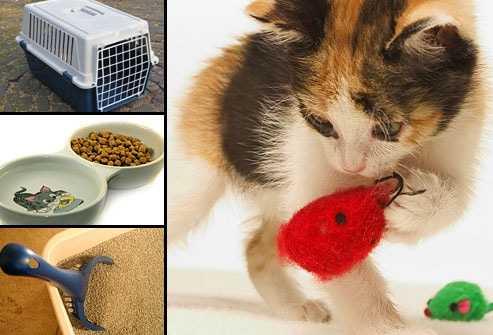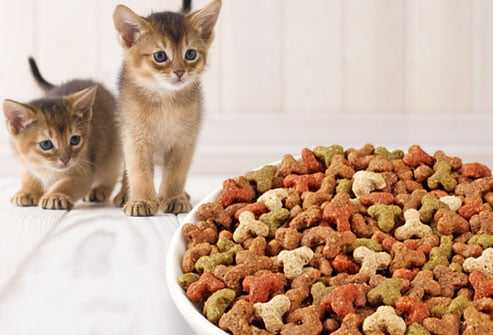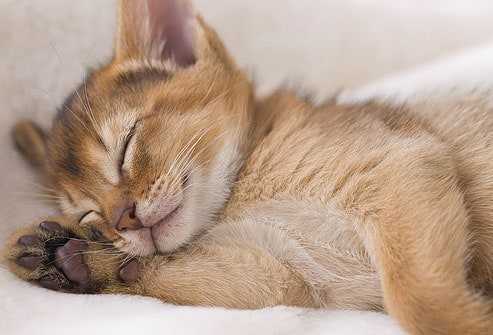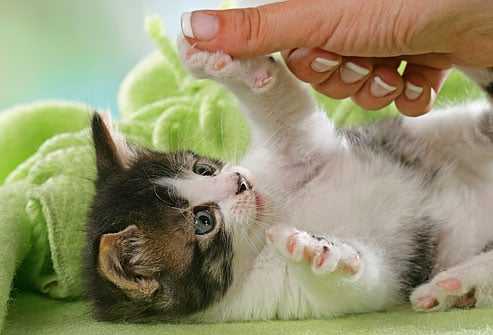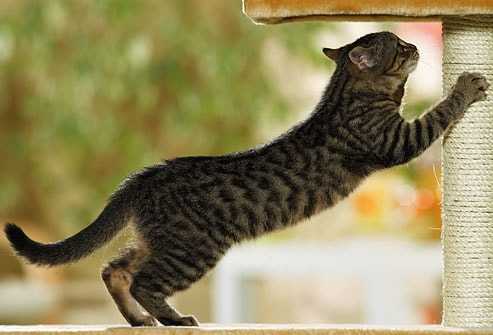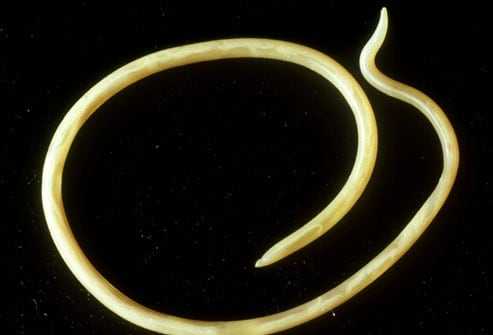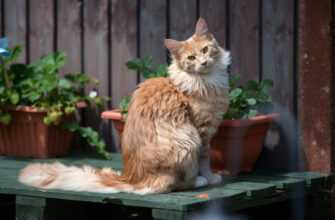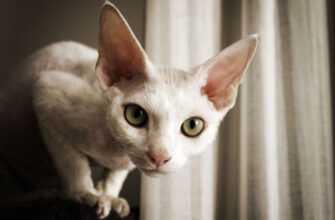Where to Adopt a Kitten
There are millions of homeless pets, so it’s a great idea to adopt your feline friend from an animal shelter or a rescue group. Pet stores and breeders can also be reputable sources, but anyone can call themselves a breeder and sell cats. Adopt from a shelter or a rescue group, and you get two feel-good bonuses: You save money and a life.
One Cat or Two?
As you cuddle kittens, you may be tempted to take home more than one. Many people who have more than one cat say that two cats give each other company and exercise. Do you have enough space? Time? Money? If the answer is yes, prepare for double the commitment — and double the rewards!
Prepare for Kitty’s Arrival
Before you bring home your kitten, make sure you have a litter box, cat carrier, kitten food, food and water bowls, a collar and tags, and toys to entertain your new pet. Cat-proof your house before kitty arrives. Put away cleaners, and pick up anything they could swallow.
Indoors or Outdoors?
Many vets suggest keeping cats indoors because indoor-only cats usually live longer, healthier lives. If you choose to keep your kitten indoors, make sure they have window perches and toys.
Do You Really Need Kitten Food?
Until they’re 1 year old, kittens need up to three times the calories as adult cats. So look for food made especially for kittens and feed your kitten the amount recommended on the label. Talk to your vet about using canned food, dry kibbles, or a mixture of both. Be sure to put the food somewhere the dog can’t get to, as kitty food can upset a dog’s stomach and add unwanted pounds.
Water, Water Everywhere
Always have lots of cool, clean water for your kitten. Put several water bowls throughout the house, and keep them clean. If you notice your kitten isn’t drinking much, try a flatter dish that doesn’t surround their small face so much. Some cats prefer moving water and may like a kitty water fountain rather than a regular bowl.
The Scoop on Litter Boxes
Cats have an instinct to poop in soil or sand, so your kitten will likely use a litter box right away. Put it in a quiet spot, and show them where it is. Kitty litter choices include regular and clumping clay litter, crystal litter, as well as litter made from wood chips, grains, and newspapers. Some cat boxes are too high for kittens to get in and out easily, so you may need to start with a low-sided box until your kitten grows.
Choose a Cat Bed
Cats sleep up to 16 hours a day, kittens even more. As much as you love cuddling with kitty, they’ll probably enjoy a spot all their own. They’ll happily curl up on a perch attached to a window ledge, a cat tree, a fuzzy pad on a chair, or in their very own snuggly cat bed. If you have a dog, it’s important to give your kitten a safe and private place to sleep.
Play With Your Kitten
By gently playing with your kitten daily, you teach them the people skills they need to be a good pet. You also help them keep fit, develop coordination, and find an outlet for behaviors like chasing and pouncing. If kitty likes to use their teeth or claws, give them something to bite on or cling to as you play. Don’t use your hand as a toy! If they think hands are toys, they might accidentally hurt someone.
Keep Kitty Safe
Cats often interact with the world through their mouth, and as cute as your kitten looks playing, not everything in your house is a good toy. Keep string, ribbon, yarn, rubber bands, plastic milk jug rings, paper clips, pins, dental floss, and other temptations away from your curious cat. Also, put away cleaning supplies, pills, and drugs, as well as antifreeze and motor oil.
Teach Your Kitten the Rules
Your kitten is new to the world and your house, so they’ll need to learn the rules. To stop some behaviors, give them other outlets. For example, to keep kitty off the curtains, give them a sisal-covered pole to climb. Don’t want them clawing the couch? Put up scratching posts. To show them the posts are OK to use, pretend to sharpen your claws on them or sprinkle catnip on them. Secure the posts well, so your cat will feel safe using them.
A Word About Declawing
Declawing kittens and cats is controversial. Cat claws are attached to bone, and surgery removes the last joint of each “finger.” People who are against declawing say it’s inhumane. Those on the other side say it can make a cat a better pet and less likely to end up in a shelter. If you declaw your cat, surgery should be done before 6 months of age. Declawed cats should always be indoors because they have trouble defending themselves.
How to Manage Scratching
Try these tips for your kitty’s claws. Nail clippers are easier to use than you think, and usually you only need to clip the front claws. Don’t cut the central pink part, or “quick” — the blood supply to the nail. Gently press the foot pads to extend the nail before clipping. Your vet can show you how. Scratching posts let cats do the work. Claw caps are tiny vinyl sleeves that fit over your cat’s claws, keeping them from doing damage.
Time to Spay or Neuter
With an estimated 6 million dogs and cats entering shelters every year, there are not enough loving families for all of them. That’s why groups like the Humane Society and the American Veterinary Medical Association recommend spaying or neutering your cat, which can be done as early as 8 weeks old. Some groups can help with the cost of surgery.
Fight Fleas
If you notice your kitten is losing hair, has irritated skin, is chewing and licking often, or is scratching a lot, they may have fleas. Ask your vet which flea control they recommend for kittens (some products also prevent heartworms), and then treat all the pets in the house. Some flea treatments used in dogs can be very toxic to cats, so always read the package carefully.
Protect Against Intestinal Worms
You can’t always avoid these parasites, but you can work with your vet to make catching them less likely. Roundworms (which cause diarrhea and vomiting), hookworms (which can cause anemia and diarrhea) and tapeworms are the most common ones your kitten will face. If you see what looks like rice grains or spaghetti in your kitten’s stool or around their bottom, see your vet for medication. Many heartworm meds have monthly dewormers.
Vaccinate Your Kitten
Your kitten’s vaccinations will help keep them healthy. Vaccines can prevent common illnesses such as rabies, feline distemper, feline leukemia, and upper respiratory infections. Talk to your vet to see which vaccines are right for your kitten.
How to Tell When Kitty Is Sick
There are signs to look for that tell you your kitten may be sick, including refusing food or water, panting, sleeping much more than usual, hiding, coughing, sneezing, vomiting, or losing weight. If you think your kitten isn’t up to snuff, talk to your veterinarian. Never give your cat something from your own medicine cabinet. Some medicine can be deadly to cats.
How to Pick a Vet
A good way to find a great vet is to ask people you trust for recommendations. Then, visit each clinic. Does the clinic look and smell clean and well-managed? Do the vets listen to you? Answer your questions clearly? Are the staff members calm and caring? Don’t be shy about changing clinics if necessary.
They Grow Up So Fast!
Like all babies, kittens seem to grow up right before your eyes, and before you know it they’re braving the world on their own. So be sure to take lots of pictures and enjoy every moment as your rough-and-tumble little kitten changes and grows into your cat companion.

 Home
Home Animal Adoption
Animal Adoption Animal Names
Animal Names Cats
Cats Dogs
Dogs

